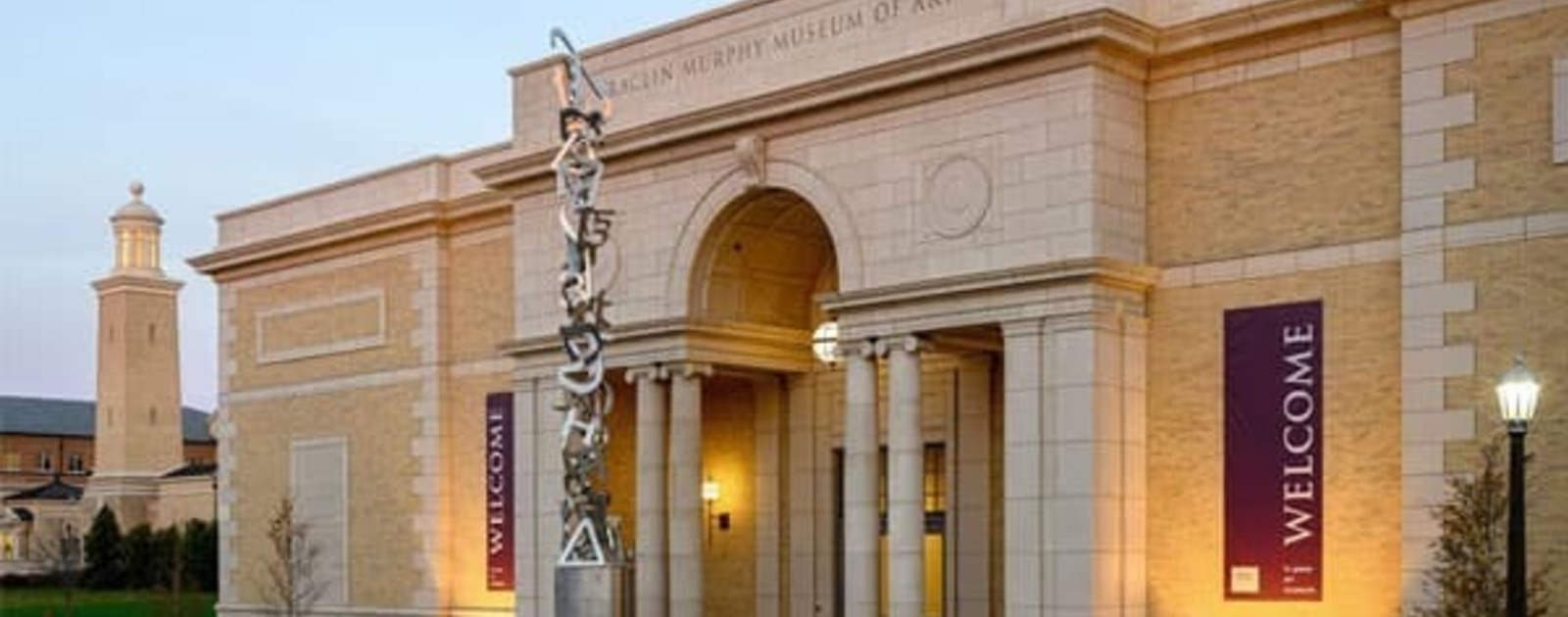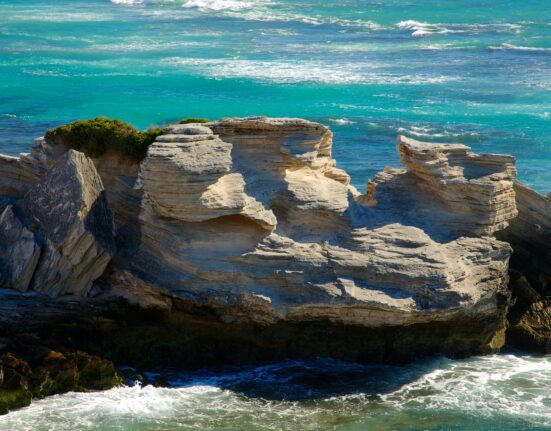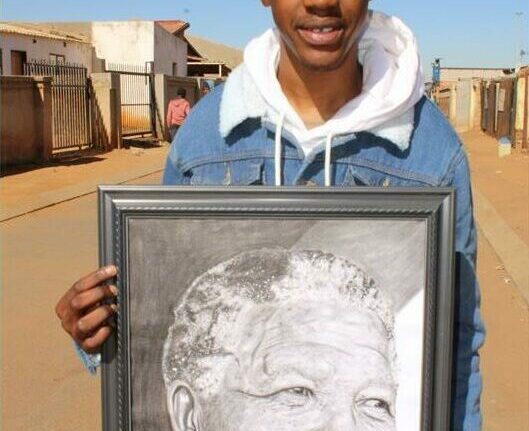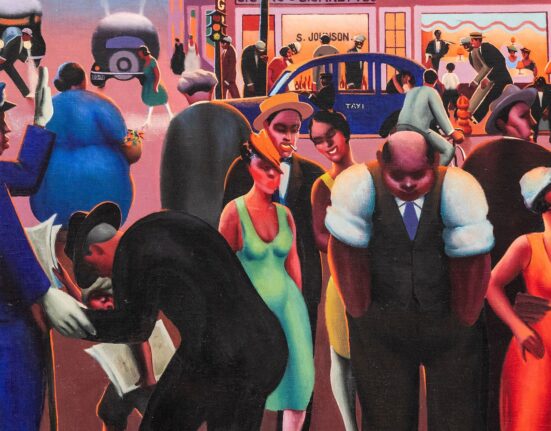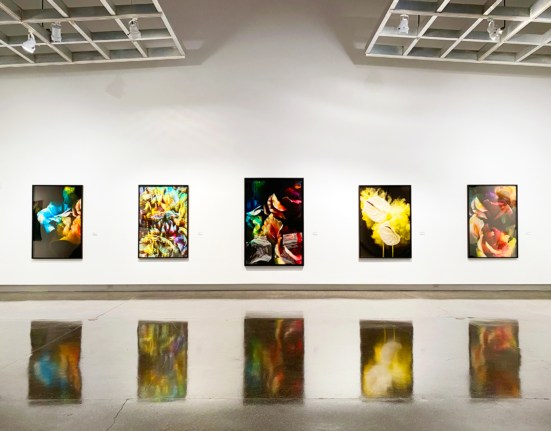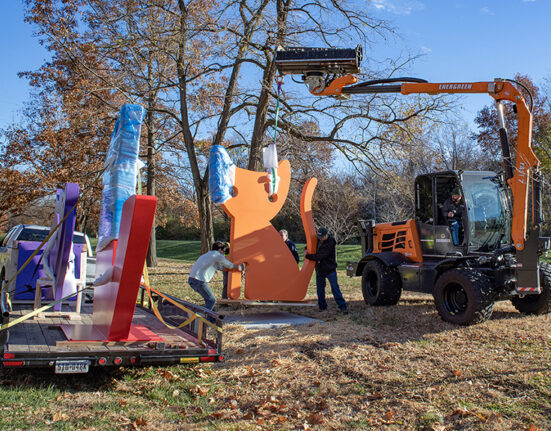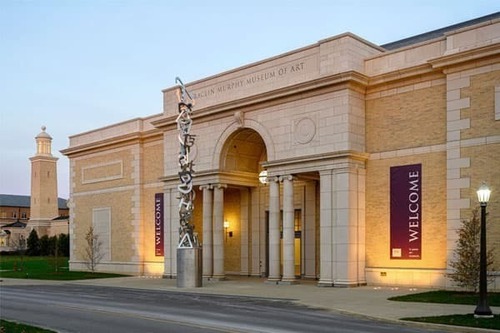
A new gateway to the University of Notre Dame continues the University’s long legacy of commitment to the arts. Welcoming visitors from across the country, the new Raclin Murphy Museum of Art opens its doors to the public Friday (Dec. 1).
The new 70,000-square-foot building on the northeast corner of Eddy Street and Angela Boulevard is designed by the award-winning firm Robert A.M. Stern Architects (RAMSA). Recognized as a leader in classical-inspired architecture, RAMSA has designed an expanded home for the University’s robust art collections that honors both tradition and innovation. The building’s brick, cast stone and Indiana limestone exterior blends with other historic buildings on campus. The new museum, occupying a prominent intersection where the University’s campus meets the greater community, will anchor and function as a gateway to an expanding on-campus arts district.
Inside, the museum’s 23 historically thematic galleries unfold around a multilevel atrium that rises to a central skylight. Classical yet contemporary, the light-flooded atrium greets visitors with works from the Raclin Murphy collection and orients them to the building’s upper and lower floors, connected by two grand staircases. A bookstore is nestled in the central atrium alongside Ivan’s Cafe, named for the Croatian sculptor Ivan Meštrović, who taught and worked at Notre Dame from 1955 until his death in 1962.
“Since its founding, Notre Dame has valued the vital role the visual arts play as an expression of human creativity, religious experience and insight into the human condition,” said University President Rev. John I. Jenkins, C.S.C. “By bringing the collections currently in the Snite Museum of Art to new life in the Raclin Murphy Museum of Art, we will be able to share these treasures in all their richness with our University community, our neighbors in the region and the wider world.”
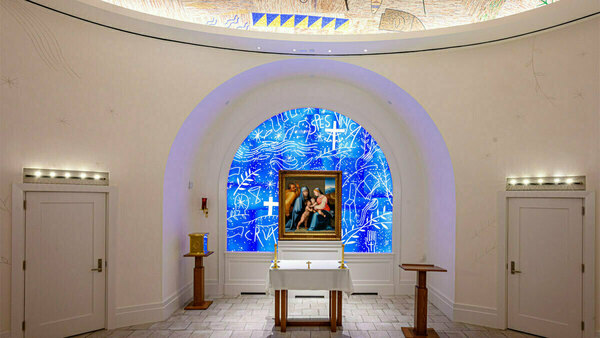
In addition to education spaces, a teaching gallery, an object study center and a chapel, the state-of-the-art galleries serve as a dramatic backdrop to works from the University’s art collection, which encompasses more than 30,000 objects. With origins that date to 1875, the collection has grown into one of the most significant and extensive collections of any academic museum in the country, with works representing many of the principal cultures and periods of world art history. The museum’s paintings, sculptures, ceramics, prints, drawings, textiles, baskets and decorative arts offer visitors a broad view of global proportions.
“The Raclin Murphy Museum of Art makes an essential contribution to Notre Dame’s strategy as a global Catholic research university for the 21st century,” said John T. McGreevy, the Charles and Jill Fischer Provost of Notre Dame. “The stunning exhibition spaces and the luminous works of art they contain will captivate us with their beauty, spark important conversations in the classroom and beyond and enable us to think in new ways about our past, present and future.”
“The permanent collection, which will celebrate its sesquicentennial in 2025, has been reinstalled with new life and vigor, giving visitors the opportunity to reconnect with and experience cherished artworks from a new perspective,” said Joseph Antenucci Becherer, director of the Raclin Murphy Museum of Art.
“Our search for knowledge is endless. It joins earth and sky.”
Newly commissioned works by globally renowned artists are integrated into the fabric of the building design, beginning with “Endless,” a 36-foot stainless steel sculpture by Jaume Plensa positioned outside of the museum entrance. Reflecting on his visits to the University and its mission, the artist noted, “Our search for knowledge is endless. It joins earth and sky.” The work of art features alphabets in eight languages and symbolizes Notre Dame’s commitment to diversity, internationalization, knowledge and global service.
A monumental carved text panel on the front facade of the building reads, “We are in the midst of reality responding with joy.” The meaningful work of art by Jenny Holzer welcomes visitors to the new Raclin Murphy Museum of Art and sets the tone for the renewed spaces inside, merging tradition and innovation in an effort to resonate with audiences from around the world.
Stepping into the atrium will reveal a circular terrazzo and bronze floor installation by Kiki Smith. “Sea of Stars,” one of the artist’s largest public projects to date, features 39 hand-drawn and cast stars inspired by celestial images frequently seen in medieval, Renaissance and Byzantine depictions of the Madonna as protectress and “Star of the Sea.” Also prominently mounted in the atrium is Maya Lin’s “St. Joseph (River) Watershed,” a reflection on our shared natural environment. The expansive relief with shimmering recycled silver honors the region’s Indigenous people and celebrates the unique geographic, sociological and environmental elements of the St. Joseph River and watershed.
Mimmo Paladino’s artistry adorns the museum’s Mary, Queen of Families chapel, a sacred space for contemplation and Masses. Paladino’s stained-glass window, incised wall frescoes and mosaic artwork on the ceiling are the result of extensive research of the University of Notre Dame, the Congregation of Holy Cross, Marian iconography and the Pokagon Band of Potawatomi. The large-scale commission will complement the medieval and Renaissance altarpieces in the chapel, offering a unique curatorial opportunity to consider the link between art history and the history of the Catholic Church.
The Raclin Murphy Museum will also unveil new acquisitions by Magdalena Abakanowicz, Zhang Huan, Dietrich Klinge, Julie Mehretu, David Ocelotl Garcia, Jamie Okuma, Yinka Shonibare, Ursula von Rydingsvard, Dana Warrington, Jason Wesaw and others. The recent acquisitions and newly commissioned art will elevate the museum’s holdings of global works and complement objects from the permanent collection, many of which underwent conservation or professional cleaning before being moved to the new building.
Located in the 9-acre Charles B. Hayes Family Sculpture Park, the museum’s location allows for the continued growth of its outdoor sculpture collection. The park installation will feature new acquisitions by Sir Anthony Caro, Dietrich Klinge, Clement Meadmore, Louise Nevelson, Beverly Pepper and Ursula von Rydingsvard among others and provide a new environment for works by Deborah Butterfield, Peter Randall-Page and George Rickey. The park’s landscape architect, Michael Van Valkenburgh, was retained for the horticultural design.
“Designed for both education and enjoyment, the Raclin Murphy Museum of Art is a place where campus and community can experience the richness of Notre Dame’s art and sculpture collections together,” said Melissa DelVecchio, partner at RAMSA.
The newly opened Raclin Murphy building is dedicated to exhibition and educational spaces. The larger vision for the museum includes additional galleries and spaces for teaching, a works-on-paper study center, administrative and curatorial offices and open collections storage. The timeline for these additional elements is to be determined.
“Along with my dedicated colleagues, we say welcome to what is and what can be. Nurturing an ongoing culture of learning through art, we’ve realized this new space to bring the campus and national community together. We have built a building and filled its spaces, but only together can we give the Raclin Murphy Museum of Art the soul it merits,” Becherer said.
The late Ernestine Raclin and her daughter and son-in-law Carmen and Chris Murphy are the lead benefactors of the Raclin Murphy Museum of Art. Admission to the Raclin Murphy Museum of Art is free. For more information, visit raclinmurphymuseum.nd.edu.

